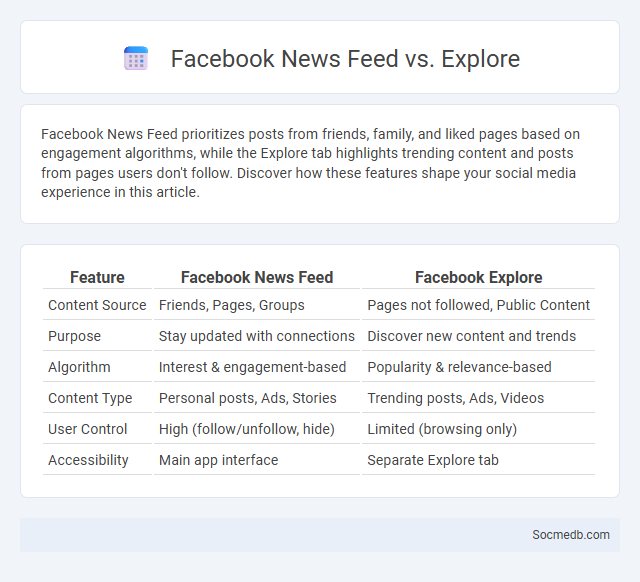
Photo illustration: Facebook News Feed vs Explore
Facebook News Feed prioritizes posts from friends, family, and liked pages based on engagement algorithms, while the Explore tab highlights trending content and posts from pages users don't follow. Discover how these features shape your social media experience in this article.
Table of Comparison
| Feature | Facebook News Feed | Facebook Explore |
|---|---|---|
| Content Source | Friends, Pages, Groups | Pages not followed, Public Content |
| Purpose | Stay updated with connections | Discover new content and trends |
| Algorithm | Interest & engagement-based | Popularity & relevance-based |
| Content Type | Personal posts, Ads, Stories | Trending posts, Ads, Videos |
| User Control | High (follow/unfollow, hide) | Limited (browsing only) |
| Accessibility | Main app interface | Separate Explore tab |
Introduction to Facebook’s Key Features
Facebook's key features include the News Feed, which curates posts from friends, pages, and groups based on user interactions and preferences. The platform integrates Messenger for instant communication and offers robust event creation and group management tools to foster community engagement. Advanced targeting capabilities support businesses in advertising through detailed demographic and interest-based filters.
What is the Facebook News Feed?
The Facebook News Feed is a dynamic, personalized stream of posts, updates, photos, videos, and links shared by friends, pages, and groups that users follow, designed to keep them informed and engaged. Algorithms prioritize content based on user interactions, such as likes, comments, and shares, to deliver relevant and timely information. This feature serves as the primary interface for discovering social content and staying connected within the Facebook ecosystem.
Understanding Facebook Explore
Facebook Explore is a feature designed to help users discover diverse content beyond their usual news feed by curating posts from pages and people they don't follow. Using advanced algorithms, Facebook Explore prioritizes relevance and user engagement, promoting content with high interaction rates to broaden exposure. This tool enhances user experience by increasing content variety and helping businesses reach new audiences through organic discovery.
News Feed vs Explore: Core Differences
News Feed delivers personalized content from friends, pages, and groups users follow, prioritizing relevance and engagement based on social connections and past interactions. Explore offers a broader discovery experience, showcasing trending and popular posts from accounts outside a user's immediate network to encourage content exploration. The core difference lies in News Feed's focus on familiar, relationship-driven content versus Explore's emphasis on discovering new and diverse media.
How Facebook’s Algorithms Curate Content
Facebook's algorithms curate content by analyzing user interactions such as likes, comments, shares, and time spent on posts to deliver personalized news feeds. Machine learning models evaluate user preferences and behavior patterns in real-time, prioritizing content that maximizes engagement and relevance. The platform continuously updates its algorithm to balance organic posts, advertisements, and trending topics, enhancing user retention and targeted advertising efficiency.
User Engagement: News Feed vs Explore
User engagement on social media varies significantly between the News Feed and the Explore section, with the News Feed generally driving higher interaction due to personalized content from friends and followed pages. The Explore tab, optimized for content discovery and trending topics, attracts users seeking new interests, although it typically results in lower engagement per post compared to the News Feed. Metrics show that users spend more time and interact more frequently with content in their News Feed, highlighting its importance for brands targeting consistent audience interaction.
Personalization and Content Discovery
Social media platforms use advanced algorithms to personalize your feed, analyzing your interests, behavior, and engagement patterns to deliver relevant content tailored just for you. Content discovery is enhanced through AI-driven recommendations, trending topics, and user-generated tags, enabling you to explore new ideas and communities seamlessly. This personalized approach boosts user engagement, making social interactions more meaningful and efficient.
Benefits and Limitations of Each Feature
Social media platforms offer features such as instant messaging, stories, and content sharing that enhance real-time communication, storytelling, and community building while driving engagement and brand visibility. Instant messaging ensures quick interaction but may lead to privacy concerns and information overload, stories allow transient content that boosts creativity but limit content longevity, and content sharing promotes viral reach yet risks spreading misinformation. Understanding the benefits and limitations of these features enables users and marketers to optimize their strategies for effective online presence and audience connection.
Impact on Publishers and Businesses
Social media platforms significantly influence publishers and businesses by amplifying content reach and enabling targeted advertising, which drives customer engagement and revenue growth. Publishers leverage social media analytics to tailor content strategies that increase audience retention and brand loyalty. Your business can harness these tools to optimize marketing efforts, boost visibility, and enhance customer interaction in competitive digital markets.
Choosing the Right Feature for Your Goals
Selecting the right social media feature hinges on understanding your target audience and desired outcomes, such as engagement, brand awareness, or conversions. Features like Stories, Reels, or Live Videos offer unique benefits tailored to real-time interaction, creative expression, or immediate feedback. By aligning your content strategy with platform-specific tools, you maximize the impact and effectiveness of your social media presence.
 socmedb.com
socmedb.com